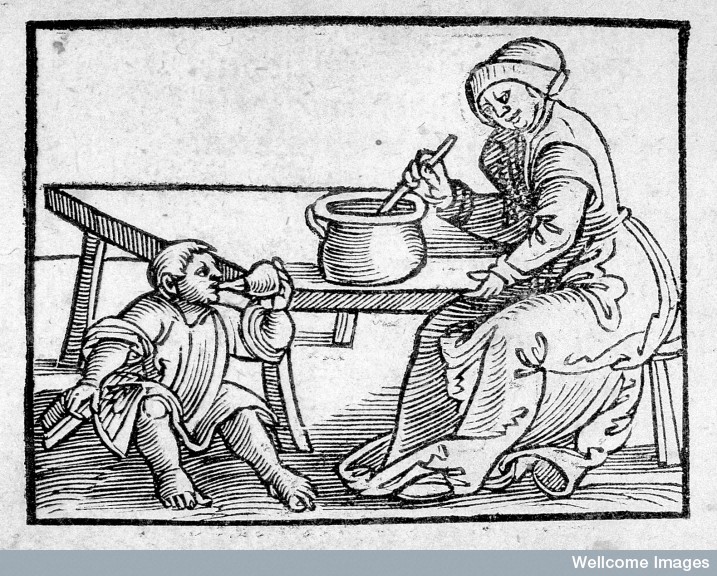
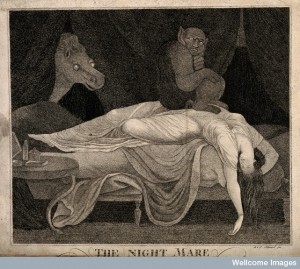 In a previous post we looked at early modern night-mares and the resemblance they bore to sleep paralysis. I have recently been researching the issue of ill-health during childhood and puberty to consider the consequences this would have on adult masculinity. As a part of this I have been reading some of the many medical texts that discussed childhood illness, like Robert Pemell’s De Morbis Puerorum, or, A Treatise of the Diseases of Children (1653) and J. S. ΠΑΙΔΩΝ ΝΟΣΗΜΑΤΑ, Or Childrens Diseases, Both Outward and Inward (1664), which was dedicated to Robert Boyle.
In a previous post we looked at early modern night-mares and the resemblance they bore to sleep paralysis. I have recently been researching the issue of ill-health during childhood and puberty to consider the consequences this would have on adult masculinity. As a part of this I have been reading some of the many medical texts that discussed childhood illness, like Robert Pemell’s De Morbis Puerorum, or, A Treatise of the Diseases of Children (1653) and J. S. ΠΑΙΔΩΝ ΝΟΣΗΜΑΤΑ, Or Childrens Diseases, Both Outward and Inward (1664), which was dedicated to Robert Boyle.
Treatises like that by J. S. discuss the sleep patterns of children and describe disturbed sleep as a medical condition. In this treatise the author first addressed the reason why newborn infants spend so much time sleeping:
‘Children never sleep moderately, for they are opprest with sleep in the womb and after they are born they sleep for the most part, because the infant is mindfull of the perpetual sleep he had in the Womb and because his body is very moist, not only by the abounding with humours, but by the sollid parts being moist and soft, the want whereof in old men and their having sollid and dry parts of their heads ( though they abound with humours) makes them most watchfull.’1
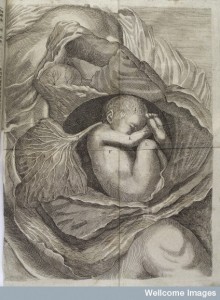
Credit: Wellcome Library, London. Wellcome Images
The memory of sleeping in the womb, then, was used as a explanation for the lethargy of babies. J. S. went on to say that when this natural pattern of sleep was disturbed, unquiet, troubled and terrifying that this was a ‘distemper’ or illness. Robert Pemell’s description of children’s nightmares appears, to a modern reader, to minimise the potential severity of the problem. He noted that Hippocrates mentions ‘great fears, and startings which is nothing else but troublesome sleep, accompanied with terrible dreams.’2 But J. S. warned that troubled sleep could be a sign of worse things to come like epilepsy and ‘other ill Diseases’.3
Both of these authors suggest that even though the disease being discussed as particular to children, it was similar to adult nightmares. J. S., for example, noted that ‘This distemper in an infant is like to the Incubus or Night-mare in these that are elder’.4 Yet neither of these authors labelled the disease as incubus or nightmare. Pemell listed this problem under the heading ‘Fear, Starting, and terrible dreams’ and J. S. recorded it as ‘Of Childrens dreaming and troubled Sleep’.5
Both of these authors explained that the fundamental cause of nightmares in children was the same as that in adults. If you remember Philip Barrough, in the Method of Physick explained that the disease was caused by excessive drinking and rawness of the stomach.6 Similarly J. S. noted that in children this problem was caused by corrupt meat, or milk, in the stomach:
‘Melancholly arises out of the corrupted meat of the Stomach whose Phantasmes are carried to the Imagination which they necessarily deterre and consequently make terrifying Dreams, which are the operations of the Imaginations about Phantasmes offered from the senses.’7
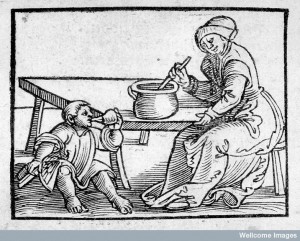
Credit: Wellcome Library, London.
Both authors, however, claimed that this was a disease that was very likely to afflict children. J. S. believed that this was because of a natural ‘debility of the Stomach’, which meant that it didn’t properly concoct food.8 Similarly Pemell explained that it was children’s inherent greed that caused nightmares; he wrote, this disease is very subject to children, who suck the milk very greedily, or eat abundantly, and so receiving more nourishment then the stomach can digest, it is corrupt, and so these vapors arise to the brain’.9 He also noted that Galen blamed a natural ‘imbecility or weaknesse’ of the child’s stomach for the commonality of this problem.10
Because troubled sleep was essentially a problem with the stomach this allowed for a rather unusual method of diagnosis, at least as far as modern readers would judge it. Pemell explained that in addition to the, expected, symptoms of crying out suddenly and starting in their sleep, ‘most times a hot and stinking vapour proceedeth out of the childs mouth.’11
The cure for these troubles was at least in one sense very straightforward it required the diet of the nurse to be amended so that the milk the child sucked would be moderate and healthy, for older children their own food would be changed:
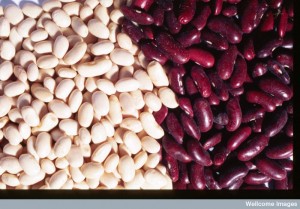
Credit: Efraim Lev and Zohar Amar. Wellcome Images
‘Let the Nurse keep to a moderate dyet, and use meats that hinder corruption, and abstain from all vitious and corrupt food; as Pease, Beans, Leeks, Onions, Colewort, &c. that so the milk may be good which the childe sucketh.’12
J. S. also recommended that ‘giving of hony to Children is commended because it clenses the Stomach and Guts.’13
As we have seen from this and the previous post on bedwetting by Hannah Newton, there were several diseases that were familiar to all age groups but were considered to be particularly relevant to the infant or pre-adolescent body. The particular make up of children’s bodies their moisture and the perceived weakness of their internal organs meant that they were more likely to suffer from certain types of illness. In this case their proximity, in terms of time, to the womb, their inherent inability to digest food well and their inherent greediness were thought to contribute to disturbed sleep and nightmares. Interestingly although it is suggested this is very similar to the nightmares experienced by adults there is no suggestion that children experienced sensations of paralysis, or visions of the devil or witches sitting on their chests.
____________
1. J .S., ΠΑΙΔΩΝ ΝΟΣΗΜΑΤΑ, Or, Childrens Diseases, both Outward and Inward. From the time of their Birth to Fourteen Years of Age. With their Natures, Causes, Signs, Presages and Cures in three books (London, 1664), p. 105.
2. Robert Pemell, De Morbis Puerorum, or, a Treatise of the Diseases of Children; with their signs, prognosticks, and cures, for the benefit of such as do not understand the Latine tongue (London, 1653), p. 22.
3. J. S., Childrens Diseases, p. 105.
4. Ibid.
5. Pemell, De Morbis Peurorum, p. 22, J. S. Childrens Diseases, p. 104.
6. Philip Barrough, The Method of Phisicke … (London, 1583), p.34.
7. J. S., Childrens Diseases, p. 106.
8. Ibid.
9. Pemell, De Morbis Peurorum, p. 22.
10. Ibid.
11. Ibid.
12. Ibid, p.23.
13. J. S., Childrens Diseases.
© Copyright Jennifer Evans, all rights reserved.
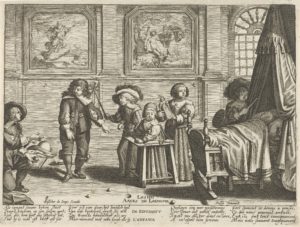

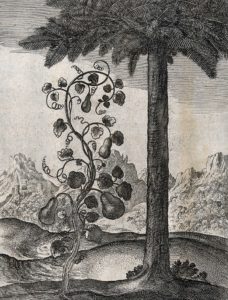
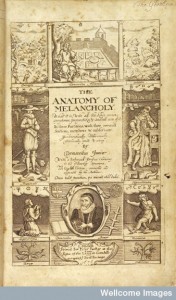
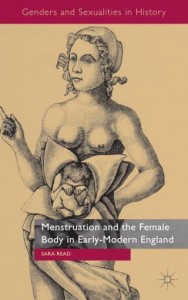
This is timely for me. I have a copy of a manuscript text from the 1640s on this topic, which I’ve been meaning to work on. I shall try to make some time for it.
Oh interesting! Would love to hear what it says about this. Although its not the focus of my research I found this topic fascinating.